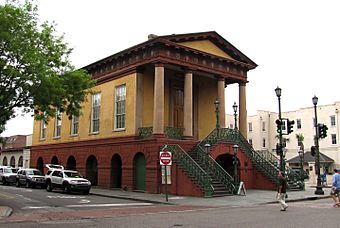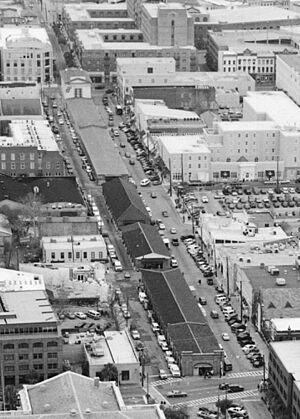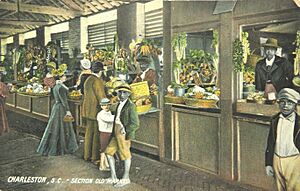City Market (Charleston, South Carolina) facts for kids
|
Market Hall and Sheds
|
|
|
U.S. National Historic Landmark District
Contributing Property |
|

Market Hall
|
|
| Location | 188 Meeting St., Charleston, South Carolina |
|---|---|
| Area | .33 acres (1,300 m2) |
| Built | 1841 |
| Architect | Edward Brickell White |
| Architectural style | Greek Revival |
| Part of | Charleston Historic District (ID66000964) |
| NRHP reference No. | 73001689 |
Quick facts for kids Significant dates |
|
| Added to NRHP | June 4, 1973 |
| Designated NHL | November 7, 1973 |
| Designated NHLDCP | October 9, 1960 |
The City Market in Charleston, South Carolina, is a famous historic market. It started in the 1790s and stretches for four city blocks. The market begins with the beautiful Market Hall and continues through many long, one-story market sheds.
It's important not to confuse the City Market with the Old Slave Mart. Enslaved people were never sold at the City Market. Market Hall is known for its "highest architectural design quality." The whole market area is listed on the National Register of Historic Places as "Market Hall and Sheds." It is also a National Historic Landmark.
The market was first called the Centre Market. It was created after the city's old Beef Market burned down in 1796. Market Hall was added in the early 1840s. It was designed by a local architect named Edward B. White. For many years, farmers sold meat and fresh produce here. It was also a popular place for people to meet and chat. Today, you can find souvenirs, jewelry, and special Gullah sweetgrass baskets from local vendors. Since 1899, Market Hall has also been home to Charleston's Confederate Museum.
Market Hall's Design
Market Hall is built in the Greek Revival style. This means it looks like ancient Greek and Roman temples. It has a raised first floor above an open archway area. The tall base and front porch, called a portico, were inspired by old temples.
The portico has four large Roman Doric columns. These columns hold up the roof structure and triangular top part, called a pediment. You reach the portico by climbing a double set of stairs with fancy iron railings. The upper walls look like they are made of carved stone blocks. The decorative parts are made of red sandstone and cement. You can see alternating bull and ram heads carved into the design. These symbols show that it was once a meat market. The outside brick walls are covered with brownstone stucco.
The City Market stretches about 1,240 feet (378 meters) long. It has a series of sheds running east to west. North Market Street is on one side, and South Market Street is on the other. Market stalls are found on the first floor of Market Hall. They continue through a long shed that goes to Church Street. More sheds stretch from Church Street to Anson Street, then to State Street, and finally to East Bay Street. These sheds are simple, rectangular buildings with open stalls and walkways. Over the years, they have been fixed up many times. This is because of damage from earthquakes, fires, and other problems.
A Look at Market History
Charleston's first public market opened in 1692. A brick building was built there in 1739. This first "Beef Market" was replaced in 1760. Soon, new markets for fish and other goods opened nearby. In 1788, a Revolutionary War general, Charles Cotesworth Pinckney, and other landowners gave land for the "Centre Market." This market would stretch from the docks to Meeting Street. They had three rules for this gift:
- The city had to use the land for Market Street and market buildings forever.
- The city had two years to build the market.
- The landowners' remaining property could not be specially taxed for building costs.
If the land wasn't used for a market, the donors could take it back.
The first market sheds were built around 1790. By 1806, they covered most of the area from the harbor to Meeting Street. After the old Beef Market burned in 1796, the beef market moved to the Centre Market. In its early days, the market mainly sold food. It had sections for beef, fish, and farm produce. It was also a social spot where people could meet. Vultures were often seen at the market. They helped keep it clean by eating discarded meat scraps. People protected them by law into the 1900s.

In 1838, a fire destroyed the main market building. The city hired Edward B. White to design the new Market Hall. It was finished in 1841. The upper room of the hall was first used as a large meeting place. Later, it became a military recruiting office when the Civil War began.
From 1881 to 1882, Charleston's mayor worked out of Market Hall. This was while Charleston's City Hall was being repaired.
In 1899, a group called the United Daughters of the Confederacy opened a Confederate Museum in Market Hall. It showed items from the city's Confederate past. The museum closed in 1989 after Hurricane Hugo badly damaged Market Hall. It later reopened after being in a temporary location.
By the early 1900s, fewer food sellers used the market. In 1901, the city council thought about replacing some sheds with a park. This idea was to save money and make the area nicer. However, people who wanted to save old buildings spoke up. They convinced the council to keep the sheds. The debate continued for several years. Preservationists suggested keeping the buildings as a covered walkway. Business leaders wanted to tear them down for a freight station. Finally, in 1905, the council decided to clean up the eastern sheds and turn them into a covered walkway. Work began in 1906. The remaining buildings were reorganized, with meat sellers on one side and fruit and vegetable sellers on the other.
On September 29, 1938, tornadoes hit Charleston. They caused a lot of damage to the City Market.
In 1954, a plane spotting tower was opened on top of one of the market sheds. It was used by the Charleston Ground Observers Corps.
After Hurricane Hugo in 1989, the City of Charleston restored Market Hall. It even won an award for the restoration in 2003. The building was repainted in its original colors. These colors included a strong yellow-brown and bright green ironwork. Many locals, including the mayor, did not like the bright new colors. A less colorful scheme had been used since 1906.
See also
- Market House (Fayetteville, North Carolina), a similar historic building
- Quincy Market, in Boston, Massachusetts
- List of National Historic Landmarks in South Carolina
- National Register of Historic Places listings in Charleston, South Carolina







